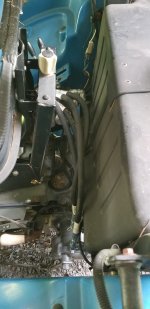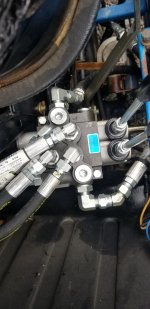I was needing another pair of rear remotes to add to my factory set. Looking around I saw options from $600 plus hoses to $1500 for another factory pair. Not really liking those options I decided to put my own kit together. What you see is a $65 open center valve body and about $280 in hydraulic hoses and fittings. I simply disconnected the feed line to my loader valve and connected it to this. The output of this new valve went back to the loader valve. It just fits behild the seat of my NH TC40. Point being you dont need to over think this like I originally did.
You are using an out of date browser. It may not display this or other websites correctly.
You should upgrade or use an alternative browser.
You should upgrade or use an alternative browser.
More options
Who Replied?
/ Dont over think rear remotes
#1
ptsg
Super Member
It may actually have to be over thought slightly, at least on how open center valves work.
Every time you use your factory remotes or the 3 pt hitch, you're pressurizing the Tank port and internal passages on the new valve which is not design for it at all.
You need to get the proper Power Beyond sleeve for that valve (those are specific to the make and model of valve), then this new line will feed the factory remotes and 3 pt hitch.
Every time you use your factory remotes or the 3 pt hitch, you're pressurizing the Tank port and internal passages on the new valve which is not design for it at all.
You need to get the proper Power Beyond sleeve for that valve (those are specific to the make and model of valve), then this new line will feed the factory remotes and 3 pt hitch.
oldnslo
Super Member
Another thought is if this is before the loader valve where is the relief valve located and operating the loader would then also pressurize the tank port.
I like your thinking but might need a little fine tuning.
I like your thinking but might need a little fine tuning.
Harry in Ky
Veteran Member
Without a power beyond sleeve in the valve you risk having the downstream circuits blocked if/when you need the relief valve to function.
Overthinking might not be necessary, but underthinking can be dangerous. Probably a good thing you decided to show us your engineering. Better order the sleeve.
Overthinking might not be necessary, but underthinking can be dangerous. Probably a good thing you decided to show us your engineering. Better order the sleeve.
Last edited:
old and tired
Veteran Member
- Joined
- Jan 15, 2019
- Messages
- 1,923
- Location
- Raleigh, NC/Hillsville, VA
- Tractor
- L2800 HST, 2005, R4 tires
So his NH TC40 is open center but no mention of needing a "Power Beyond" plug... I'm just trying to learn what an "Open Center" system is vs. "Open Center with Power Beyond".You need to get the proper Power Beyond sleeve for that valve (those are specific to the make and model of valve)...
Is it two different animals???
LouNY
Super Star Member
- Joined
- Jul 4, 2015
- Messages
- 14,309
- Location
- Greenwich, NY
- Tractor
- Branson 8050, IH 574, Oliver 1550 Diesel Utility (traded in on Branson) NH 8160. Kioti CK2620SECH
An "open center" hydraulic system circulates all the fluid the hydraulic pump is pumping through all of the control valves until a valve is actuated which is literally just blocking the normal circulating route and rerouting oil out of another port which is opened as the flow through port was closed.
This has the effect of pressurizing every thing in the flow path prior to that valve.
The following picture is how multiple control valves should be plumbed.
The internal porting in the control valve will direct high pressure oil to the activated A or B port at the same time the other A or B port will be directed to the tank line.
If T port is piped to a P port the first control valve will see pressure on the low pressure internal ports of it when the second valve is operated. This will often result in unintended operation of cylinders on the first valve because of pressure on the backside of the porting which should have been returned to the tank, very low pressure.
Also going in series using the T to the P port eliminates the relieving properties of the first valve.
These valves should always have the T port going to the "tank" reservoir which is a low pressure side of the system regardless of want the control valves do. The P and N ports are designed for the periodic applications of the system pressure when operated. The T port and line is not. The T ports and hosing can be tee's together as long as the sizing does not create back pressure.

This has the effect of pressurizing every thing in the flow path prior to that valve.
The following picture is how multiple control valves should be plumbed.
The internal porting in the control valve will direct high pressure oil to the activated A or B port at the same time the other A or B port will be directed to the tank line.
If T port is piped to a P port the first control valve will see pressure on the low pressure internal ports of it when the second valve is operated. This will often result in unintended operation of cylinders on the first valve because of pressure on the backside of the porting which should have been returned to the tank, very low pressure.
Also going in series using the T to the P port eliminates the relieving properties of the first valve.
These valves should always have the T port going to the "tank" reservoir which is a low pressure side of the system regardless of want the control valves do. The P and N ports are designed for the periodic applications of the system pressure when operated. The T port and line is not. The T ports and hosing can be tee's together as long as the sizing does not create back pressure.
CalG
Super Member
- Joined
- Sep 29, 2011
- Messages
- 9,185
- Location
- vermont
- Tractor
- Hurlimann 435, Fordson E27n, Bolens HT-23, Kubota B7200, Kubota B2601
My trouble with "under thinking" is the positioning of both the hose couplings and the control levers.
I did add a three spool "loader valve" to the Hurlimann. (That was an effort!) I used a Lamborghini valve just to keep in the spirit of the effort. (This Hurlimann 435 Prince was sold by Lambo dealers , but painted white...The SAME version was red ;-)
I did add a three spool "loader valve" to the Hurlimann. (That was an effort!) I used a Lamborghini valve just to keep in the spirit of the effort. (This Hurlimann 435 Prince was sold by Lambo dealers , but painted white...The SAME version was red ;-)
So I need the sleve on the T port and that's it? No 3rd lineIt may actually have to be over thought slightly, at least on how open center valves work.
Every time you use your factory remotes or the 3 pt hitch, you're pressurizing the Tank port and internal passages on the new valve which is not design for it at all.
You need to get the proper Power Beyond sleeve for that valve (those are specific to the make and model of valve), then this new line will feed the factory remotes and 3 pt hitch.
Going by this diagram I need the power beyond sleve and to connect the T port to the cover on the 3rd function cap.An "open center" hydraulic system circulates all the fluid the hydraulic pump is pumping through all of the control valves until a valve is actuated which is literally just blocking the normal circulating route and rerouting oil out of another port which is opened as the flow through port was closed.
This has the effect of pressurizing every thing in the flow path prior to that valve.
The following picture is how multiple control valves should be plumbed.
The internal porting in the control valve will direct high pressure oil to the activated A or B port at the same time the other A or B port will be directed to the tank line.
If T port is piped to a P port the first control valve will see pressure on the low pressure internal ports of it when the second valve is operated. This will often result in unintended operation of cylinders on the first valve because of pressure on the backside of the porting which should have been returned to the tank, very low pressure.
Also going in series using the T to the P port eliminates the relieving properties of the first valve.
These valves should always have the T port going to the "tank" reservoir which is a low pressure side of the system regardless of want the control valves do. The P and N ports are designed for the periodic applications of the system pressure when operated. The T port and line is not. The T ports and hosing can be tee's together as long as the sizing does not create back pressure.
View attachment 3635621
Does the valve in the pic even have a N port?
Attachments
Harry in Ky
Veteran Member
You're still not getting it. The sleeve goes in the N port and yes you need the third line. T port needs to connect to tractor sump by whatever means necessary. It can have a dedicated line to the tractor case or to a tee in the existing sump return line from the loader valve.
If the valve doesn't have an N port you bought the wrong valve.
If the valve doesn't have an N port you bought the wrong valve.
Similar threads
- Replies
- 1
- Views
- 2K




